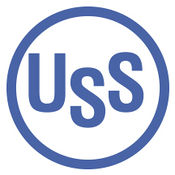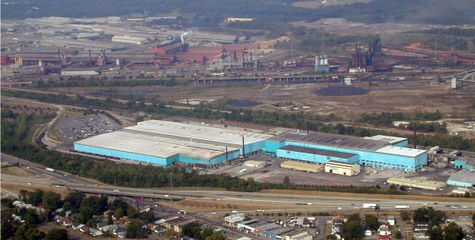U.S. Steel: Difference between revisions
No edit summary |
|||
| (4 intermediate revisions by the same user not shown) | |||
| Line 2: | Line 2: | ||
[[File:US Steel logo.jpg|right|175px]] | [[File:US Steel logo.jpg|right|175px]] | ||
[[File:US Steel sign.jpg|right|thumb|325px|Sign outside the U.S. Steel Administrative Offices at Fairfield Works]] | [[File:US Steel sign.jpg|right|thumb|325px|Sign outside the U.S. Steel Administrative Offices at Fairfield Works]] | ||
The '''United States Steel Corporation''' | The '''United States Steel Corporation''' was a steel producer based in Pittsburgh, Pennsylvania which had significant production facilities in the [[Birmingham District]] since it acquired controlling interest in the [[Tennessee Coal, Iron and Railroad Company]] (TCI) in [[1907]]. The company itself was founded in [[1901]] when banker J. P. Morgan engineered the merger of the Carnegie Steel Company, Federal Steel Company, National Steel Company. | ||
TCI operated as a subsidiary of U.S. Steel until it was absorbed as a division of the parent company in [[1952]]. Under Pittsburgh ownership, TCI operated the massive [[Ensley Works]] and constructed the [[Fairfield Works]] in the planned community of [[Fairfield]]. The TCI subsidiary, bolstered by capital and executive leadership from U.S. Steel, proved to be so efficient at making cheap steel that the company levied an internal tariff (the '[[Pittsburgh Tariff]]') in [[1909]] in an effort to prevent the Birmingham product from undercutting the profitability of the Pittsburgh mills. | TCI operated as a subsidiary of U.S. Steel until it was absorbed as a division of the parent company in [[1952]]. Under Pittsburgh ownership, TCI operated the massive [[Ensley Works]] and constructed the [[Fairfield Works]] in the planned community of [[Fairfield]]. The TCI subsidiary, bolstered by capital and executive leadership from U.S. Steel, proved to be so efficient at making cheap steel that the company levied an internal tariff (the '[[Pittsburgh Tariff]]') in [[1909]] in an effort to prevent the Birmingham product from undercutting the profitability of the Pittsburgh mills. | ||
In [[1925]] TCI completed the [[High Ore Line Railroad]], providing a direct supply route from its [[iron ore]] mines at [[Wenonah]] to the furnaces in Fairfield. | In [[1925]] TCI completed the [[High Ore Line Railroad]], providing a direct supply route from its [[iron ore]] mines at [[Wenonah]] to the furnaces in Fairfield. At its peak during [[World War II]], U.S. Steel employed more than 340,000 people, including 45,000 in the Birmingham District. | ||
The company moved its headquarters offices from the [[Brown-Marx Building]] in [[downtown Birmingham]] to the [[Flintridge Building]] in Fairfield in [[1951]]. In [[1964]] the company consolidated most of its higher-level administrative offices in Pittsburgh. In that same decade, U.S. Steel closed down most of its mining operations and began importing ores and fuels from overseas. | The company moved its headquarters offices from the [[Brown-Marx Building]] in [[downtown Birmingham]] to the [[Flintridge Building]] in Fairfield in [[1951]]. In [[1964]] the company consolidated most of its higher-level administrative offices in Pittsburgh. In that same decade, U.S. Steel closed down most of its mining operations and began importing ores and fuels from overseas. | ||
The corporation was re-organized as '''USX''' in [[1986]], after diversifying into petroleum with the acquisition of [[Marathon Oil]] and into real estate development of former mining properties. Those businesses were spun off in [[2001]]. | The corporation was re-organized as '''USX''' in [[1986]], after diversifying into petroleum with the acquisition of [[Marathon Oil]] and into real estate development of former mining properties. Those businesses were spun off in [[2001]]. In [[2008]] Nucor of Charlotte, North Carolina surpassed U.S. Steel as America's largest steel producer. | ||
[[File:Fairfield Works.jpg|left|thumb|475px|Aerial view of U.S. Steel's operations in Fairfield]] | [[File:Fairfield Works.jpg|left|thumb|475px|Aerial view of U.S. Steel's operations in Fairfield]] | ||
| Line 20: | Line 18: | ||
Construction of the [[U.S. Steel Electric Arc Furnace]] later resumed, representing an investment of $412 million. Production of recycled steel tubular products began on [[October 20]], [[2020]]. | Construction of the [[U.S. Steel Electric Arc Furnace]] later resumed, representing an investment of $412 million. Production of recycled steel tubular products began on [[October 20]], [[2020]]. | ||
In December [[2023]] U.S. Steel announced that it had agreed to be acquired by Nippon Steel of Tokyo, Japan. American operations would continue to operate under the U.S. Steel name, with business offices in Pittsburgh. The offer was accepted by shareholders even after the [[United Steelworkers]] voted to reject any sale to a non-unionized, non-American buyer. President Joe Biden promised to block the sale and to support domestic production by increasing tariffs on steel imported from China. | |||
{{stub}} | {{stub}} | ||
==Birmingham area operations== | |||
* [[Ensley Works]] (1952–1976) | |||
* [[Fairfield Works]] (1952–2015) | |||
* [[High Ore Line Railroad]] (1952–) | |||
* [[Birmingham Southern Railroad]] (1952–2011) | |||
* [[Fairfield Tubular Operations]] (1952–2015) | |||
* [[Fairfield Wire Works]] (1952–1979) | |||
* [[Marathon Oil]] (1986–2001) | |||
* [[American Bridge|Virginia Bridge Co.]] / [[American Bridge]] (1952–1965) | |||
* [[U.S. Steel Electric Arc Furnace]] (2020–) | |||
==References== | ==References== | ||
* ''Biography of a Business'' (1960) United States Steel Corporation ISBN B000R2Q8CU | * ''Biography of a Business'' (1960) United States Steel Corporation ISBN B000R2Q8CU | ||
| Line 29: | Line 40: | ||
* Thornton, William (February 11, 2020) "U.S. Steel’s Fairfield electric arc furnace nearing completion." {{BN}} | * Thornton, William (February 11, 2020) "U.S. Steel’s Fairfield electric arc furnace nearing completion." {{BN}} | ||
* Thornton, William (October 27, 2020) "U.S. Steel announces successful startup of $412 million Fairfield electric arc furnace." {{BN}} | * Thornton, William (October 27, 2020) "U.S. Steel announces successful startup of $412 million Fairfield electric arc furnace." {{BN}} | ||
* Thornton, December 10, 2020) "How US Steel’s $412 million Fairfield electric arc furnace works." {{BN}} | * Thornton, William (December 10, 2020) "How US Steel’s $412 million Fairfield electric arc furnace works." {{BN}} | ||
* Isidore, Chris (December 18, 2023) "US Steel, once the world’s largest corporation, agrees to sell itself to a Japanese company." CNN.com | |||
* "Biden vows to stop Japanese company’s US Steel purchase: ‘It should remain totally American’." (April 17, 2024) Associated Press/{{AL}} | |||
==External links== | ==External links== | ||
| Line 37: | Line 50: | ||
[[Category:U.S. Steel|*]] | [[Category:U.S. Steel|*]] | ||
[[Category:1952 establishments]] | [[Category:1952 establishments]] | ||
[[Category:2024 disestablishments]] | |||
Latest revision as of 12:20, 19 April 2024
- This article covers the steel company after reorganization in 1952. For the local subsidiary prior to that, see Tennessee Coal, Iron and Railroad Company.
The United States Steel Corporation was a steel producer based in Pittsburgh, Pennsylvania which had significant production facilities in the Birmingham District since it acquired controlling interest in the Tennessee Coal, Iron and Railroad Company (TCI) in 1907. The company itself was founded in 1901 when banker J. P. Morgan engineered the merger of the Carnegie Steel Company, Federal Steel Company, National Steel Company.
TCI operated as a subsidiary of U.S. Steel until it was absorbed as a division of the parent company in 1952. Under Pittsburgh ownership, TCI operated the massive Ensley Works and constructed the Fairfield Works in the planned community of Fairfield. The TCI subsidiary, bolstered by capital and executive leadership from U.S. Steel, proved to be so efficient at making cheap steel that the company levied an internal tariff (the 'Pittsburgh Tariff') in 1909 in an effort to prevent the Birmingham product from undercutting the profitability of the Pittsburgh mills.
In 1925 TCI completed the High Ore Line Railroad, providing a direct supply route from its iron ore mines at Wenonah to the furnaces in Fairfield. At its peak during World War II, U.S. Steel employed more than 340,000 people, including 45,000 in the Birmingham District.
The company moved its headquarters offices from the Brown-Marx Building in downtown Birmingham to the Flintridge Building in Fairfield in 1951. In 1964 the company consolidated most of its higher-level administrative offices in Pittsburgh. In that same decade, U.S. Steel closed down most of its mining operations and began importing ores and fuels from overseas.
The corporation was re-organized as USX in 1986, after diversifying into petroleum with the acquisition of Marathon Oil and into real estate development of former mining properties. Those businesses were spun off in 2001. In 2008 Nucor of Charlotte, North Carolina surpassed U.S. Steel as America's largest steel producer.
Until 2015 the company operated the Fairfield Works, one of its five integrated steel mills, manufacturing hot-rolled, cold-rolled and coated sheet products; and Fairfield Tubular Operations, which manufactures seamless steel pipe.
U.S. Steel shut down its Birmingham blast furnace in late 2015, idling around 1,100 workers. At the time, there were plans to construct a new electric arc furnace that would employ about 300 in production of steel from recycled materials for use in the pipe mill, but those plans were tabled due to low demand from energy companies for steel tubular products.
Construction of the U.S. Steel Electric Arc Furnace later resumed, representing an investment of $412 million. Production of recycled steel tubular products began on October 20, 2020.
In December 2023 U.S. Steel announced that it had agreed to be acquired by Nippon Steel of Tokyo, Japan. American operations would continue to operate under the U.S. Steel name, with business offices in Pittsburgh. The offer was accepted by shareholders even after the United Steelworkers voted to reject any sale to a non-unionized, non-American buyer. President Joe Biden promised to block the sale and to support domestic production by increasing tariffs on steel imported from China.
Birmingham area operations
- Ensley Works (1952–1976)
- Fairfield Works (1952–2015)
- High Ore Line Railroad (1952–)
- Birmingham Southern Railroad (1952–2011)
- Fairfield Tubular Operations (1952–2015)
- Fairfield Wire Works (1952–1979)
- Marathon Oil (1986–2001)
- Virginia Bridge Co. / American Bridge (1952–1965)
- U.S. Steel Electric Arc Furnace (2020–)
References
- Biography of a Business (1960) United States Steel Corporation ISBN B000R2Q8CU
- Warren, Kenneth (2001) Big Steel: The First Century of the United States Steel Corporation, 1901-2001 Pittsburgh, Pennsylvania: University of Pittsburgh Press ISBN 0822941600
- Gray, Jeremy (April 10, 2015) "What would Birmingham be without US Steel?" The Birmingham News
- Poe, Kelly (May 19, 2016) "US Steel CEO gives update on postponed $277 million Fairfield project." The Birmingham News
- Thornton, William (February 11, 2020) "U.S. Steel’s Fairfield electric arc furnace nearing completion." The Birmingham News
- Thornton, William (October 27, 2020) "U.S. Steel announces successful startup of $412 million Fairfield electric arc furnace." The Birmingham News
- Thornton, William (December 10, 2020) "How US Steel’s $412 million Fairfield electric arc furnace works." The Birmingham News
- Isidore, Chris (December 18, 2023) "US Steel, once the world’s largest corporation, agrees to sell itself to a Japanese company." CNN.com
- "Biden vows to stop Japanese company’s US Steel purchase: ‘It should remain totally American’." (April 17, 2024) Associated Press/AL.com
External links
- United States Steel Corporation website
- Fairfield Works and Fairfield Tubuler Operations at ussteel.com


